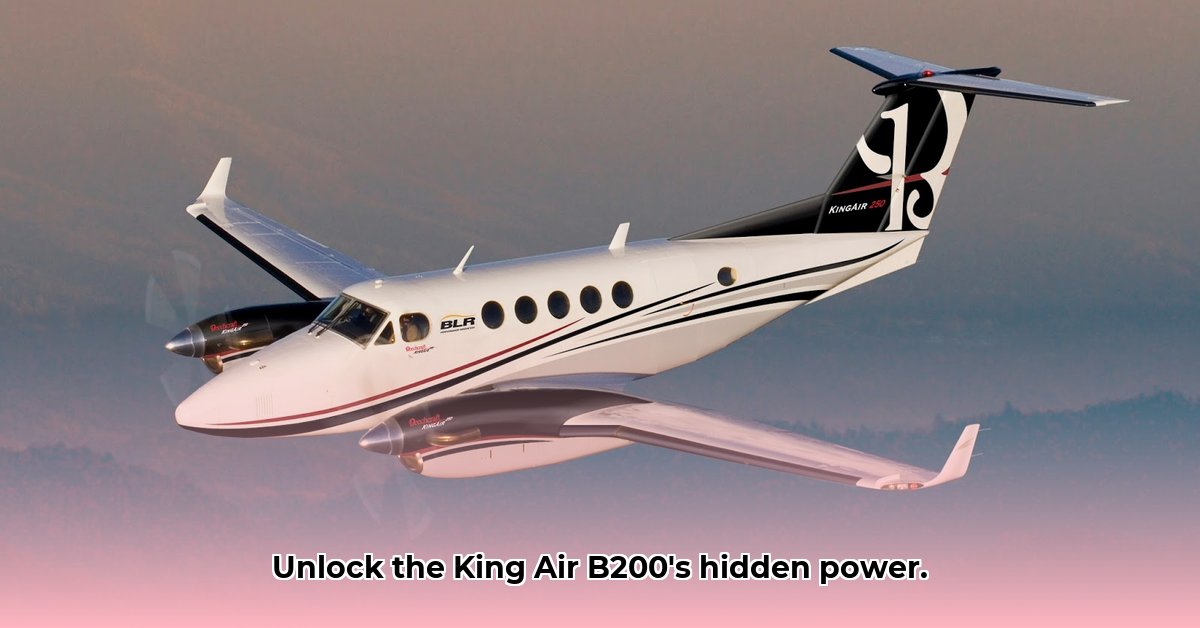
Beechcraft King Air B200: A Legacy of Versatility and Performance
The Beechcraft King Air B200 is more than just a turboprop; it’s a legend in the aviation industry. Since its introduction in the mid-1970s, this aircraft has proven its worth time and again, adapting to diverse operational needs across various sectors. Its enduring popularity speaks volumes about its robust design and consistent performance. But owning and operating a B200 requires understanding its nuances – from maintenance to operational costs to market standing. This guide will help you navigate those complexities.
A History of Refinement: Performance and Upgrades Over Time
The King Air B200's success story is one of continuous improvement. Early models, now considered classics, laid a solid foundation for the aircraft we know today. Subsequent upgrades have significantly enhanced its capabilities. Notable advancements include engine upgrades from the PT6A-42 to the more powerful PT6A-52, and corresponding propeller improvements, resulting in enhanced efficiency and performance. These ongoing enhancements solidify the B200's position as a leader in its class. Isn't consistent improvement a key factor in long-term value retention?
Adaptability for Diverse Missions: Versatility in Action
The B200's versatility is a defining characteristic. Its adaptability extends across numerous operational roles, from medical evacuation to military applications. Various models, such as the B200SE, B200T, B200C, and B200GT, further highlight this impressive range of capabilities. This flexibility contributes to its sustained popularity across diverse sectors. How does this versatility impact the overall return on investment for operators?
Managing Operational Expenses: A Realistic Look at Costs
Operating any aircraft involves significant costs. For the Beechcraft King Air B200, these expenses are influenced by factors such as maintenance frequency, fuel consumption (mitigated by engine and propeller upgrades), and the overall condition of the aircraft. Regular, scheduled maintenance is paramount in minimising unexpected expenses and ensuring optimal operational efficiency. Proactive planning and diligent maintenance are essential to control operational costs effectively. What strategies can significantly reduce the long-term operating costs of a B200?
Maintaining Market Leadership: A Strong Market Position
The Beechcraft King Air B200's long production run reflects its consistent market demand and appeal. The lack of a truly comparable aircraft with the same longevity underscores its enduring success. This sustained market position is due largely to its proven reliability, performance, and versatile operational capabilities. What factors contribute to its continued dominance in the turboprop market?
Navigating the Future: Challenges and Opportunities
Textron Aviation faces both challenges and opportunities in maintaining the B200's market leadership. Staying ahead of the curve requires continuous innovation. Embracing emerging technologies, such as electric propulsion and advanced materials, will be crucial for the B200's continued evolution and long-term viability. What innovative approaches can Textron Aviation take to ensure the B200 remains a competitive force in the future?
Key Considerations for B200 Owners and Operators
| Aspect | Key Considerations |
|---|---|
| Maintenance | Regular scheduled maintenance is crucial for minimizing downtime and unexpected costs. |
| Engine Life | Proper engine maintenance extends lifespan and reduces long-term costs. |
| Avionics Upgrades | Modern avionics enhance safety and pilot experience, but careful cost-benefit analysis is essential. |
| Fuel Efficiency | Optimising flight planning and techniques directly impacts fuel consumption and costs. |
The Beechcraft King Air B200 stands as a testament to robust design and adaptability. Understanding its operational intricacies, cost structure, and future prospects is essential for anyone considering ownership or operation. By focusing on these key aspects, operators can truly unlock the B200's full potential. Does the B200’s continuous evolution suggest a sound long-term investment opportunity?
Comparing Beechcraft King Air Performance Against Competitors: A Case Study
Understanding Your Mission Profile: Tailoring the Aircraft to Your Needs
Choosing between aircraft like the Beechcraft Super King Air and the Piaggio P.180 Avanti requires a clear understanding of your operational requirements. Factors such as mission range, payload capacity, speed, and passenger comfort are crucial considerations. A thorough analysis of your specific needs will guide you towards the most suitable aircraft. How important is speed versus payload capacity in your mission profile?
Key Performance Indicators (KPIs): Head-to-Head Comparison
A direct comparison of key performance indicators is vital for an informed decision.
| Feature | Beechcraft King Air 350iER | Piaggio P.180 Avanti EVO |
|---|---|---|
| Maximum Speed | ~310 kts | ~400 kts |
| Useful Load | Higher | Lower |
| Range | Significantly Higher | Lower |
| Cabin Size/Comfort | Spacious, but more utilitarian | More luxurious, smaller |
| Operating Costs | Generally lower per hour | Generally higher per hour |
Note: These are general comparisons. Precise figures will depend on specific configurations and conditions.
A Step-by-Step Comparison Approach
- Define your mission: Clearly outline flight distances, passenger/cargo requirements, and operational needs.
- Gather specifications: Collect precise data from reputable sources (manufacturer websites, aviation publications) on speed, range, payload, operating costs, and cabin dimensions.
- Analyse operating costs: Carefully calculate hourly operating costs, encompassing fuel, maintenance, insurance, and crew salaries. Consider potential variations based on missions.
- Evaluate resale value: Research the used aircraft market to assess resale values and depreciation rates for both aircraft types.
- Weigh pros and cons: Consider the advantages and disadvantages of each aircraft based on your specific operational requirements.
- Consult experts: Seek advice from experienced aviation professionals for refined decision-making.
Beyond the Data: Subjective Considerations
Remember, some aspects are inherently subjective. Cabin comfort and aesthetics are important considerations. Prioritise features that best align with your preferences and operational needs. Does the unique cabin design of the Avanti outweigh the King Air's superior range for your specific operations?